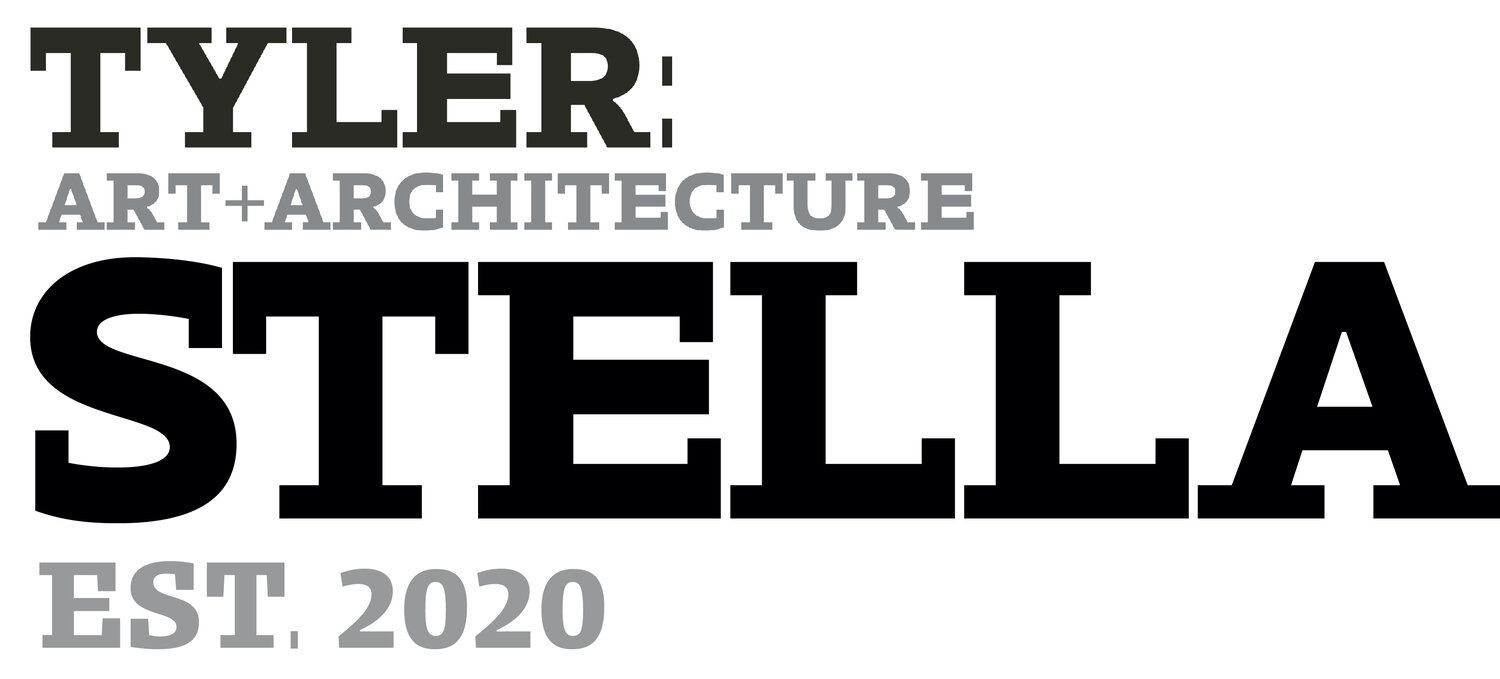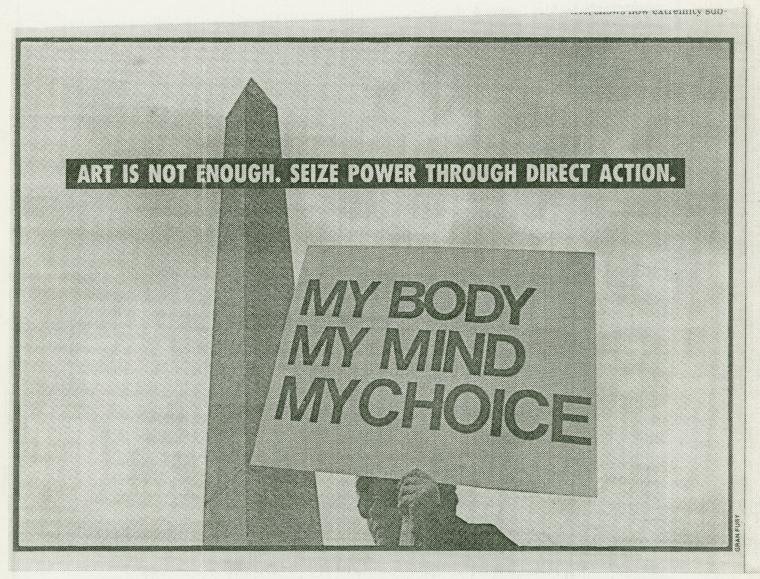Zoe Cudney
Art Is Not Enough But It Cannot Be Ignored
Art Is Not Enough [Seize Power through Direct Action], 1987 - 1995, Photocopy of newspaper clipping The rapid development of the HIV / AIDS epidemic in the United States was perpetuated by a two-pronged misinformation agenda proliferated by the United States government and the mainstream media; first, a program of erasure and silence, and second, a cultivation of false information including a lack of pressure or funding for adequate medical research and drug development. My research examines the use of art as a tool to counter both of these facets of propaganda. I explore the work of collective Gran Fury as means of asserting visibility for queer communities and of the epidemic itself, but also as means of offering factually-based education on the realities of AIDS, including the government's involvement in the escalation of the health crisis into epidemic. Gran Fury was formed following the installation of a window-piece at the New Museum in 1987 organized by the AIDS Coalition to Unleash Power (ACT UP).
In a 1989 interview with the group, member Michael Nesline, described the function of the collective, saying “ [ … ] all of us are interested in creating art work—or propaganda—that addresses the AIDS crisis and that will be seen by different parts of the public and affect their understanding of this crisis. It would provoke them, cause a reaction, make them think, and hopefully educate them.” This articulates the lenses through which my research examines the intention and impact of the work of Gran Fury.
Some of these works served as means of provocation, intending to garner a reaction, positive or negative. Others functioned as catalysts for thought by calling attention to inaccuracies and gaps in public thinking about the AIDS / HIV epidemic. Some offered spaces of education, filling and correcting those gaps. While not distinct, these categories offer structures through which to examine the effectiveness of art at countering propagandist narratives.
AIDS: 1 in 61, 1988, Poster, 17 x 22 in. An early work of the collective, these posters aimed to counter two interconnected, false misrepresentations in mainstream media. First, that heterosexual women did not need to worry about HIV transmission through sex. Second, that primarily white individuals were contracting HIV. One out of sixty-one babies born in New York City were born HIV-positive. The lack of reporting on this statistic was directly reflective of racism as a contributing factor to the broader misrepresentation of AIDS / HIV statistics. These posters are text-heavy compared to much of the group’s later work. They are also bilingual, demonstrating early efforts by Gran Fury to speak to those most impacted by the epidemic but who were simultaneously being ignored and forgotten. Not always successful, similar attempts at intersectionality were a critical struggle for a group composed of mostly white members. It was a requirement of the work, as propagandist narratives about AIDS / HIV were not exclusively false reporting, but also a total lack thereof.
Wall Street Money, 1988, Fliers (paper), 10 1/2 x 3 3/4 in. (each) These pieces of “money” were made for an action on Wall Street in March of 1988. At the time, only one drug was offered for those who were HIV positive, AZT. In addition to only offering one option for medication, AZT was, at the time, one of the most expensive prescription drugs ever offered. These pieces of “money” were handed to passerbyers on Wall Street, intending to call awareness to the lack of funding for HIV-treatment research but more critically, to the role of pharmaceutical companies in limiting this research for profits. An affinity group managed to get into the floor of the stock exchange and threw handfuls of the “money” off the balcony. That action halted trading for a few minutes. No one had demonstrated on the stock exchange floor before, thus garnering massive attention, especially from the press, and offering both ACT UP and Gran Fury an opportunity to articulate their demands.
In 1989 in New York City, you could purchase The New York Times each morning from newsstand boxes for a quarter. Gran Fury created these mock newspaper covers, replacing “The New York Times” with “The New York Crimes” and substituting advertisements with their own images. The articles were replaced with pieces written by Gran Fury and ACT UP members based upon or in response to writing previously published in The Times which had ignored or misreported information about the AIDS / HIV epidemic. Gran Fury mapped the distribution routes of the papers, and then followed the trucks with rolls of quarters, removing and replacing the newspapers after substituting the front pages with these mock ones. This action both called attention to the complacency of the mainstream media and their active role in the spread of misinformation surrounding the epidemic, and also countered these false narratives, providing the public with accurate statistics and perspectives from those directly impacted.
The New York Crimes, 1989, Mock newspaper (newsprint), 14 3/4 x 22 3/4 in. Kissing Doesn't Kill, 1990, Color postcard of bus board, 8 1/2 x 4 in. Initially installed on buses in Chicago in August of 1990, these boards were the continuation of multiple “kiss” related projects staged by the collective and ACT UP. These boards responded to the public fear that the virus was transmissible via saliva (people were being arrested for spitting on cops) while also intending to advertise that a) safe sex and sexiness were positive, rather than something to be fearful of, and b) that safe sex and AIDS awareness was for not only white, gay men but also non-queer individuals, women, and people of color. Most of the bus boards were quickly defaced, however these reactions served as a public dialogue, or what Tom Kalin described as “Democracy in action.” Lesbian activists used white spray paint to remove the couples except the lesbian one on some, intending to call attention to the erasure of lesbians and women in the discourse surrounding the epidemic.
Zoe Cudney
(she/her)
Art History ‘24
Zoe Cudney is a senior Art History student, currently interested in the intersection of queer art, protest art, new media art, and the ways art and visual culture construct societal networks. Originally from Vermont, she moved to Philadelphia in an unsuccessful attempt to escape winter, but she has become too entrenched in this weird and wild city to leave anytime soon. In lieu of any career aspirations, she hopes to spend her time after graduation reading, gardening, and bothering everyone around her with conversations about art as a tool for simultaneous fun and systemic disruption.







